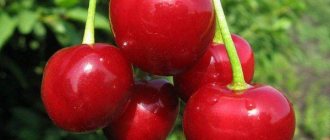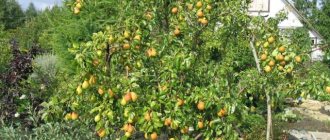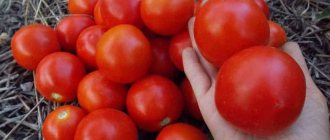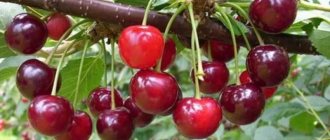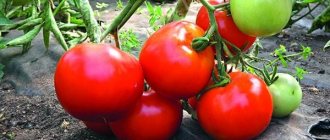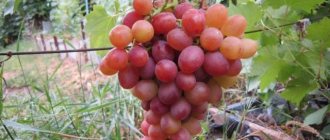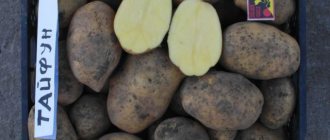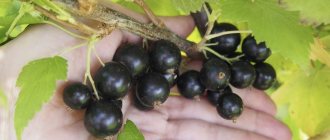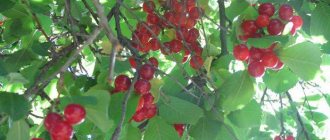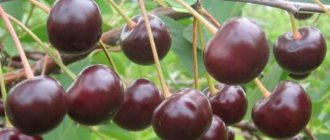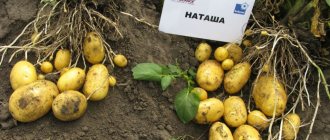Brief history of origin and distribution
Brusnitsyn's cherry is considered a popular variety in amateur gardens. However, the plant is not included in the State Register. Thanks to its winter hardiness and unpretentious care, this example of folk selection is successfully practiced by residents of the Urals and Siberia.
Recently, there has been a tendency to spread culture to other areas. Not only gardeners from harsh regions are showing interest, but also residents of the southern part of the country. Brusnitsyna also shows its best qualities when grown in areas with a mild climate.
Harvesting
Cherry berries ripen at the same time, so it is advisable to complete the harvest in one day . Ripe berries do not tend to crumble or crack, but birds will happily feast on them, so the harvest must be harvested quickly. It fits well and withstands transportation . It is better to freeze the berries of this variety for the winter or cook them into compotes, jams, or prepare juices.
Brusnitsyn's cherry is an unpretentious tree that survives both severe frosts and dry hot days. A relatively high percentage of self-fertility allows you to get a harvest even if it is not possible to plant pollinators nearby. These qualities attract gardeners, which made the variety popular.
Characteristics and description of the tree
The bushy tree has a spreading form. During the season, skeletal branches throw out a large number of shoots 30-35 cm long. Bright green foliage densely covers the plant. The leaf shape is elongated, the edges are serrated, the apex is pointed. The height of an adult cherry reaches 2 meters.
The greatest aesthetic pleasure can be observed during the flowering period of a culture. At the end of spring, snow-white inflorescences appear. Almost all the greenery is covered with beautiful flowers. As the berries ripen, the branches are overloaded with a generous harvest.
Resistance to diseases and pests
Brusnitsyna has a strong immune system. During prolonged rains or when grown in flooded areas, there is a tendency to be affected by monoliosis and coccomycosis. You can protect yourself from pests by carrying out preventive treatments.
One of the important activities is collecting fallen leaves in the fall and pruning damaged and diseased shoots. Plant residues must be disposed of by burning. The soil in the area of the trunk circle is thoroughly loosened by turning over the top layer (up to 7 cm).
Rules of care
Brusnitsyna cherry seedlings
In the fall, you need to trim off diseased branches and fertilize the bush. The latter is done once every two years. It is better to choose organic matter as a top dressing:
- bird droppings;
- manure;
- compost;
- complex organic fertilizers.
The quality of fertilizer is the main criterion for obtaining a bountiful harvest.
In the following video, watch how to care for cherries and replant them:
Cherry is a tasty and healthy fruit that is grown in every garden. There are a huge number of cherry varieties - registered and unregistered. One of the unregistered ones, distinguished by its qualities and unpretentiousness, is the Brusnitsyn cherry variety.
Productivity and fruiting period
The variety belongs to late ripening crops. The cherry blossom period begins in the third decade of May. The peculiarity of Brusnitsina is the long viability of pollen (2-3 weeks). On a bush tree, about 40% of the fruits are formed due to the self-fertility of the plant. Yields can be increased by 19-12% by planting pollinators near the cherries. But even without them, it is possible to consistently obtain generous harvests. The berries turn red and fill with juice in August.
A young tree begins to bear fruit 3-4 years after planting. At the age of 6-7 years, 15-20 kg of ripe berries can be harvested from one plant.
Description of the variety
Brusnitsyn's cherry is a lignified low bush with widely spreading branches and a large number of fruits. Belongs to the Pink family, genus Plum, subgenus Cherry. From the Latin language “Cerasus - cherry”, the name comes from the city of Kerazund, from which cherry seedlings were first exported to Rome. The following describes the characteristics of the Brusnitsyn cherry variety.
The bushes grow up to 200 cm in height, bloom profusely in the 4th-5th year, after which green fruits are formed, which, when ripening, become purple in color. Flowers bloom in the middle - end of May.
The fruits are large, round, the weight of one berry is up to 6 g. Inside the berry there is a small round seed that is easily separated from the pulp. The fruit has a sweet and sour taste, the flesh is fleshy and juicy. The annual yield of an adult plant is 12-20 kg.
Last year's shoots have a woody appearance, the bark is brown-gray, young shoots are green. The branches are flexible and can be easily cut with pruning shears. The leaves are glossy, bright green above, light green below. Petiolate, elliptical in shape, up to 8 cm in length, pointed at the end. The edges of the leaves have small teeth.
The root system is powerful, growing up to 1.5-2 m in depth and width. The variety is suitable for cultivation in frost resistance zone 3-4, withstands frosts down to -40 °C, northern regions of Russia. Brusnitsyn's cherry is an early variety, flowering lasts 2.5-3 weeks.
Advantages and disadvantages of the variety
Like no one else, residents of regions with harsh climates appreciated all the benefits of the Brusnitsyn variety. Among the main advantages of bush cherries:
- consistently high productivity;
- self-fertility, no need to worry about planting pollinators, look for a place for them in a small garden;
- interesting taste of the fruit, where sweet and sour notes are intertwined;
- compact plant size;
- high winter hardiness;
- strong immunity;
- ability to withstand dry weather for a long time;
- unpretentiousness to agricultural technology;
- short adaptation period;
- high decorative qualities.
Taking into account the reviews of experienced gardeners, the Brusnitsyna variety has no disadvantages. Some gourmets point out the predominance of acid in the taste, but this is inherent in the vast majority of varieties of cherries.
Brusnitsyna cherry: description and characteristics of the variety, planting and care, photo
Cherry is the favorite fruit tree of many gardeners. It is valued for its ease of care and the pleasant sweet and sour taste of the fruit. There are a huge number of varieties of this tree, but more often they prefer to grow one on the plot - the Brusnitsyn cherry. Why the variety deserves such attention, and how to grow it correctly, we will tell you further.
Description of the variety
A 200 cm tall cherry tree with strong but flexible skeletal branches forming a pyramidal crown. 30-35 centimeter shoots extend from each of the branches, appearing in the summer and densely covered with green foliage.
The sheet plate is 80 mm long and 40 mm wide. Its surface is covered with a small amount of waxy coating that seals the sheet. Along the contour of the leaf plate there are teeth, and its edge is pointed.
The bushy, compact form of the Brusnitsyn cherry is also suitable for decorative purposes both in the orchard and on the plot
The tree blooms late, at the end of May. Inflorescences appear on the shoots and consist of 2–4 snow-white flowers. The variety is self-fertile. Without pollinators, 40% of the ovary will form on the tree. To improve performance, it is necessary to plant other varieties of cherries with the same flowering period nearby.
Important! The variety tolerates both temperature drops down to –40°C and jumps up to +38°C.
Characteristics of berries
The fruits of Brusnitsyn's cherries can be characterized as follows:
- medium size, weighing 4–6 g;
- round shape and rich red color;
- the peel is dense, with a waxy coating;
- ripe berries do not crack or rot;
- the pulp is juicy, soft, fibrous, with high taste;
- the taste is dominated by sweetness, 15% sugar;
- universal use;
- ripen towards the end of summer.
Advantages and disadvantages of the variety
- Among the positive qualities of Brusnitsyn’s cherries are:
- self-fertility;
- long-term preservation of pollen properties (2-3 weeks);
- high frost resistance;
- drought resistance;
- rapid maturation of hearths;
- high yield;
- good immunity;
- unpretentiousness in cultivation;
- compactness of the plant.
- Among the shortcomings are noted:
- demands on the landing site;
- Although the variety is self-fertile, without pollinators the yield is 40%.
Landing Features
To get a good harvest, as well as to simplify plant care, you need to choose the right place for planting. In addition, the timing of planting work should also be taken into account.
Landing dates
It is recommended to plant Brusnitsyn cherries in the spring, when consistently warm weather sets in and the soil warms up well . Each region has its own deadlines. If the seedling is not with open roots, but with closed ones, in containers, then autumn planting can be done until mid-September.
Selecting a location
You should choose a place for planting that is protected from winds and well lit by sunlight . The ideal location is the southern or southwestern side of the site. The bed should be on a hill so that groundwater does not come close to the roots of the plant.
If there is no hill, you can form a bed 50 cm high. Sandstone, loam, and chernozem are suitable for the tree . If the soil is light, you need to mix in clay and humus. Sand, peat, and humus are added to heavy soils. Acidity should be at a neutral level.
A sunny location has a beneficial effect on the accumulation of sugars in fruits
Undesirable places for planting crops:
- near a fence or permanent structure (in spring moisture is retained here, and in winter it can be covered with snow);
- near coniferous plants (may start to hurt);
- in lowlands (moisture, cold stagnates);
- in partial shade, shade (the fruits lose their sweetness).
Late cherry varieties also include:
Site preparation
The site chosen for planting is prepared in the fall . The bed is plowed, all plant debris and other debris are removed. Humus or compost is added to the soil.
Dig a hole with dimensions of (0.6–0.8) × (0.6–0.8) × (0.4–0.6) m. Its bottom is lined with a drainage layer. 3 kg of humus is poured on top.
Until spring, all nutrients will be absorbed into the soil and will help the young plant to take root faster in the spring.
Direct drop off
The process of planting a seedling looks like this:
- At the end of March, form a mound 30 cm high at the bottom of the hole. Place mineral and organic fertilizers nearby.
- Place a support peg in the center of the embankment.
- Soak the root system of the seedling for 15 minutes. in water.
- Remove rotten and excess roots.
- Straighten the root system of the seedling and place it in a hole on an embankment.
- Cover the roots with soil so that the root collar of the plant is level with the soil.
- Compact the soil with your hands and water the plant with 30 liters of warm water.
- Mulch the tree trunk circle with peat. Tie the seedling to a stake.
When planting several bush cherries nearby, you must leave a distance of at least 3 m between the holes.
Subtleties of wood care
Caring for the crop is simple; no special knowledge in the agricultural technology of fruit plants is required.
Watering
After planting, the young plant needs abundant watering . They are carried out every 14 days. One tree needs to spend 20 liters of warm water.
Water is poured through trenches dug along the contour. It’s interesting to read how long cherries live.
A couple of days after the irrigation procedure, when most of the moisture is absorbed by the soil, it is necessary to loosen the tree trunk circle and remove weeds, if necessary.
Top dressing
When a sufficient amount of nutrients is added to the hole during planting, the cherries are fed for the first time two years after planting . It is better to apply fertilizers in the fall at first. Then every year, in spring and autumn, they will need to be added to the soil in the tree trunk circle .
Important! During the period of fruit ripening, the tree can also benefit from fertilizing. Ammonium nitrate is used (30 g/5 l, 10 l per tree).
When feeding in autumn, it is recommended to use humus (5 kg/1 m²) or superphosphate solution (30 g/5 l). 10 liters of solution is poured under each tree. In spring feeding, you can use a solution of potassium nitrate (30 g/10 l of water, 10 l per plant).
Whitewash
Whitewashing of any trees is carried out in the spring to protect the bark from the scorching rays of the sun . For these purposes, use a lime solution (1 kg/2 l).
To prevent the whitewash from being washed off during rains, PVA or laundry soap is added to it. Before the procedure, the bark is cleaned of moss, debris and fungus.
The trunk is covered with lime from its base to the first branching of the branches, capturing their bases.
Trimming
Brusnitsyn's cherry does not need crown formation. Only dry and diseased branches need to be trimmed.
We also recommend reading how to make cherries bear fruit.
Diseases and pests
The variety was bred to be resistant to major diseases and pests , but in years favorable for the development of fungal diseases, it can be affected by coccomycosis and moniliosis .
For preventive purposes, it is necessary to promptly remove fallen leaves, carefully dig up the tree trunk, and in the spring treat the tree with Bordeaux mixture.
This remedy also helps against powdery and downy mildew.
Fleas and mites can infect cherries . Acyclovir (40 g/7 l) will help get rid of them. Each treatment should be carried out at intervals of 10–15 days until the scourge disappears.
Harvesting
Cherry berries ripen together, so it is advisable to complete the harvest in one day.
Ripe berries do not tend to crumble or crack, but birds will happily feast on them, so the harvest must be harvested quickly. It fits well and withstands transportation .
It is better to freeze the berries of this variety for the winter or cook them into compotes, jams, or prepare juices.
Brusnitsyn's cherry is an unpretentious tree that survives both severe frosts and dry hot days. A relatively high percentage of self-fertility allows you to get a harvest even if it is not possible to plant pollinators nearby. These qualities attract gardeners, which made the variety popular.
Source: https://fermer.blog/bok/sad/plodovye-derevya/vishnya/sorta-vishni/pozdnie-sorta-vishni/5581-vishnja-brusnicyna.html
Optimal conditions
You need to choose the right place for the seedling. It should not be in lowlands or swampy areas. Drafts are dangerous for a young tree, so it is better to avoid drafty areas.
The variety develops well and bears fruit in mixed soils (fertile soil with sand). If, when digging a hole for a seedling, high density is detected, the soil is lightened with sand and clay.
Other important conditions include:
- low groundwater level;
- moderate air humidity;
- diffused light.
Planting seedlings
Brusnitsyn's cherry tree
Ideal landing spot:
- protected from winds;
- well lit;
- located in the southwestern or southern side of the site;
- elevated (roots should not be close to groundwater);
- with sandy loam soil of neutral acidity.
Where you should not plant cherries:
- Under the fence (in winter it may be covered with snow).
- Near coniferous crops (cherries can often get sick).
- In lowlands with high humidity.
Once the location has been chosen, you can start working with a shovel. Dimensions for planting hole:
- width – 60-80 cm;
- length – 60-80 cm;
- depth – 40-60 cm.
When digging a hole, the soil should be thrown in one direction and then mixed with organic fertilizers. A peg is dug into the center of the hole. Then the planting mixture is poured into a cone. The roots of the seedling are carefully straightened over the resulting hill.
This garden crop does not like deep planting, so the root collar should be level with the soil. You need to fill the soil gradually, constantly slamming it with your hands. To water, you need to dig a hole and pour 30 liters of warm water into it.
Afterwards, mulch the surface of the earth with peat, and tie the seedling to a stake for stability. That's all. It remains to wait 3-4 years. Afterwards you can harvest the first harvest.
Landing dates and rules
For planting cherries, you should choose elevated areas located on the southwestern side of the garden. They must be reliably protected from the winds. The seedlings will be warmer in the harsh winter if they are located not far from wooden buildings.
The best time for planting is spring. Taking into account the climatic characteristics of the northern regions, work can be planned for the 2-3rd decade of April. During the summer, the tree will have time to form a strong root system and gain strength before the first winter. If you plant it in the fall, then the chances of survival in severe frosts are negligible.
The productivity and health of cherries are influenced by nearby growing crops. The following plants have a beneficial effect on the growing season:
- hawthorn;
- cherries;
- honeysuckle;
- currant.
It is not advisable to plant tall apple trees, apricots, lindens, and conifers in close proximity to cherries. And you should completely abandon the proximity to raspberries, gooseberries and other representatives of the nightshade family. They are sources of common fungal infections.
The seedling also needs preparation. 10 hours before planting, it is wrapped in a well-damp cloth to soften the roots. Re-moisten the fabric as necessary to prevent it from drying out.
Sequence of planting work.
- In the selected area, dig a hole up to 60 cm deep with sides from 60 to 80 cm. The soil from the hole should be laid out separately to the side, and then mixed with fertilizers and sand if the soil is compacted.
- Check the roots of the seedling. If necessary, cut off rotten and damaged fragments.
- Place a peg made of durable material in the center of the recess.
- Introduce a mixture of soil and fertilizer into the central part of the hole. Pour it out so that a slide is formed. The following fertilizers are used: potassium, phosphorus, wood ash, humus.
- Pour 2 buckets of water into the hole and let it soak.
- Carefully lay out the root shoots on the hill formed in the hole. The root collar should be flush with the soil surface.
- Introduce the soil gradually, slapping your hands over the mound.
- Step back from the trunk about 30 cm and form a hole that defines the trunk circle. It is needed to drain liquid to the roots.
- Tie the seedling to a support.
Reference! Experienced gardeners recommend not watering the tree trunk after planting. It is better to moisten the tree again after 3-4 days. After irrigation, you need to lay a layer of peat mulch.
Do not drive in a metal rod or wooden stick that acts as a support after planting the seedling. This can damage the root system. Compliance with the sequence eliminates the risk of damage to the roots and the plant as a whole.
Landing Features
To successfully grow Brusnitsyna cherries, choose a suitable location and planting period.
Recommended timing
Brusnitsyn's cherry takes root well when planted in early spring, after warm weather sets in. This statement is relevant for seedlings with bare roots. If a gardening farm offers planting material in containers, seedlings of the Brusnitsyna variety can be transplanted into open ground until mid-September.
Choosing a suitable location
For cherries, select the southern or southwestern side of the garden, where there will be enough lighting for it. In the central regions, the Brusnitsyna variety tree is placed in a spacious sunny place. In the south of the country, it is better to plant low-growing bush cherries in light partial shade.
It is important to follow the following recommendations when planting cherries:
- Places with stagnant water or low-lying areas are not suitable for planting Brusnitsyn cherries.
- If there are no hills, raised ridges up to 0.5 m high are made, and seedlings are planted on them;
- Sandy and loamy soils are the best for cherry crops;
- On heavy soils, sand, peat and humus are added to the holes;
- Clay and humus are added to peat soils;
- The optimal soil composition for planting Brusnitsyn seedlings should have neutral acidity levels. Acidic soil is alkalized with lime.
Advice! A sunny location has a beneficial effect on the accumulation of sugars in fruits.
What crops can and cannot be planted next to cherries?
Brusnitsina is self-fertile, but the yield will increase if other varieties of cherries or sweet cherries are grown in the garden. Nearby you can plant low plants: currants, honeysuckle, hawthorn. Raspberries, gooseberries, and nightshades are undesirable neighbors, as they can become a source of the spread of fungal diseases. It is also undesirable to plant tall apricots, apple trees, linden trees, and any coniferous trees next to cherries.
Selection and preparation of planting material Before planting Brusnitsyn cherries, seedlings are carefully inspected for roots and trunk, discarding dried and damaged specimens. The height of the trunk to the branches is at least 60 cm, thickness within 2 cm.
The branches should be elastic, long, with well-developed buds. Before planting, the roots are soaked in a mixture of water, clay, and a growth stimulant (optional).
Landing algorithm
In the hole for planting cherry seedlings of the Brusnitsyna variety, fertilizers are added to the required substrate: horse humus, 500 ml of wood ash, 1 tbsp. l. potassium chloride and 2 tbsp. l. superphosphate.
Further actions:
- They hammer in a peg to which the tree will later need to be tied;
- A seedling is installed in the planting hole and sprinkled with prepared substrate. The root collar remains above the surface;
- After watering the hole, mulch the ground;
- The branches are cut by one third.
Warning! When purchasing planting material, it is better to give preference to 2-year-old seedlings.
Further care
After planting, the tree is watered regularly. In the first month, irrigation is carried out 1-2 times a week. In hot weather, you need to moisturize more often (2-3 times a week). The water requirement is from 20 to 40 liters. However, the degree of soil moisture should be monitored. Excessive moisture will cause root rot.
Periodically, the soil near the tree trunk needs to be loosened to enrich the roots with oxygen. At the same time, weeding is carried out. They are removed to prevent rotting of the root collar.
Throughout the warm season, the tree is sprayed against pests and diseases with special fungicides or insecticides. Products prepared according to folk recipes are also used.
Cherry trees are pruned annually. It is advisable to do this in spring and autumn. At the beginning of the season, frozen or damaged shoots are removed. In autumn, excess and diseased branches are cut off from the tree, and the bush is formed.
During the season you need to fertilize 2-3 times. The first occurs in the spring before the buds open. For this period, it is appropriate to use a nitrogen composition. During flowering, fertilize with a potassium-phosphorus mixture. In the fall, in the process of preparing the plant for winter, it is recommended to use mineral multi-component products.
Description of culture
Outwardly, Novella does not at all resemble a bird cherry. The pollinator gave the tree its powerful roots, which support a medium-sized tree about 3 m high. Its crown is wide and round. The branches are straight, brown-brown, and become bare over time. The leaves of the tree are matte, dark green, obovate, with pointed ends of the leaf blade and jagged edges.
Did you know? Cherries are so highly valued in the United States that February 20 was chosen as National Cherry Pie Day. And in the state of Utah it received the status of an official symbol.
The size of the petioles is up to 3 cm, the buds are ovoid, slightly behind the branches. The flowers are whitish, collected in inflorescences of 4 pieces, located on bouquet shoots or one-year-old shoots. The berries are one-dimensional, wide-round, slightly flattened at the top and base, with an average weight of up to 5 g and a diameter of up to 2 cm. The berries of the variety are completely dark burgundy in color, reaching final ripeness they become almost black.
The pulp is medium-dense and does not develop cracks, which is why the fruit tolerates transportation well. The fruits are separated well from the stalks. The cherry pit is small, round, yellowish, and easily removed from the pulp. Experts gave it 4.2 points for its juiciness and sweet and sour taste.
Brief characteristics of the variety
Novella is a cold-resistant, mid-early, high-yielding variety. With good care, the tree practically does not get sick and regularly produces good harvests.
Drought resistance and winter hardiness
Cherry is intended for the Central Black Earth regions, where it shows good frost resistance, and its bark and cambium tolerate local winters well. However, in too harsh a period, the tree’s buds may freeze slightly. The variety has satisfactory resistance to drought; watering during particularly hot periods should be 1-2 times a month.
Learn how to plant cherries in the fall.
Pollination, flowering period and ripening time
Trees of the Novella variety bloom approximately 2-3 weeks before the start of summer; depending on climatic conditions, the first buds appear between May 10 and May 18. The ripening of cherries is mid-early, simultaneous, and harvesting begins in mid-summer.
The variety is partially self-fertile, therefore it needs pollinating neighbors located no further than 40 m. The best pollinators of this variety are Griot Ostgeimsky, Vladimirskaya and Shokoladnitsa cherries.
Productivity and fruiting
Novella bears its first fruits 4 years after planting; they ripen at the same time and are ready for harvesting around July 15th. According to the authors of the variety, cherries show good yield per 1 hectare: average - 77.6 centners, maximum - 99.8 centners. At the same time, one mature tree produces about 15 kg of berries. These figures are especially impressive given the relatively small growth of trees.
Did you know? Cherries also have their own long-livers. Thus, in the north-west of England, a 150-year-old cherry tree about 13 m high with a spreading crown with a diameter of more than 5 m grows and continues to actively bear fruit.
In good conditions, Novella shows stable high fruiting, but after a harsh winter the buds may partially freeze, and the yield may decrease significantly. Since the variety is quite young and was registered only in 2001, there are not yet sufficient statistics on its life expectancy. However, breeders claim that Novella is a potential long-liver, capable of bearing fruit until a very old age - about 20 years.
Resistance to diseases and pests
Due to the fact that Novella is a cerapadus, i.e. one of its parent varieties was crossed with bird cherry; it has good immunity to many diseases of fruit trees. Cherry is highly resistant to coccomycosis and moniliosis, and is less often affected by pests compared to other varieties of this crop.
You will be interested to know how to distinguish cherries from sweet cherries.
In order for the tree to remain healthy, the entire necessary set of agrotechnical measures should be regularly carried out - pruning, fertilizing, watering and others.
Advantages and disadvantages of the variety
- It is worth especially noting the following advantages of the Novella:
- resistance to coccomycosis and other fungal infections;
- good yield;
- resistance to winter temperatures;
- partial self-fertility;
- long productive period;
- simultaneous ripening of fruits;
- large, one-dimensional, tasty berries;
- resistance of berries to cracking;
- small seed and universal use of the fruit.
- Disadvantages include:
- average bud resistance to severe frosts;
- unstable fruiting, depending on climate.
- impossibility of cultivation in the northern regions;
- exposure of old shoots;
- there is an “unclean” tearing of berries from the stalks.
Possible problems, diseases, pests
With proper care, Brusnitsyn's cherry does not cause any trouble. If you ignore pruning or fertilizing, the plant may become diseased. Among the main reasons provoking the development of the pathological process:
- prolonged rains;
- warm and humid weather;
- plant remains in the form of leaves and twigs that remain under the tree.
The Brusnitsyna variety has strong immunity, but in the presence of predisposing factors, the plant can get sick:
- coccomycosis (a fungal infection is recognized by brown spots merging into one large spot on the leaves);
- monoliosis (a fungal disease affects the fruits, causing them to turn brown).
The condition of cherries can also deteriorate due to harmful insects. Among the main pests:
- cherry fly;
- aphid;
- cherry weevil;
- sawfly.
To eliminate problems, it is recommended to use folk recipes and special preparations for parasites. The following products are popular: Aktara, Horus, Enzhio, Actellik, Switch.
Description of the Brusnitsyn cherry variety, yield characteristics and frost resistance
Cherry is a tasty and healthy fruit that is grown in every garden. There are a huge number of cherry varieties - registered and unregistered. One of the unregistered ones, distinguished by its qualities and unpretentiousness, is the Brusnitsyn cherry variety.
Advantages and disadvantages
One of the main advantages of the Brusnitsyn cherry variety is its ease of cultivation:
- The variety is resistant to severe frosts and temperature changes. Withstands up to -40 °C.
- The fruits ripen quickly and the yield is high.
- Resistant to diseases.
- Unpretentious to the growing location and soil.
- Affordable and convenient bush height for harvesting.
- Self-fertility. The ability of flowers to be pollinated by their own pollen, which is a particularly valuable advantage in growing conditions in northern regions with unstable weather conditions.
The main disadvantage of the described Brusnitsyn cherry variety is that it requires careful selection of a place, protected from strong gusts of wind and drafts. The variety requires formative pruning annually. For greater pollination of flowers, you can plant the Mayak cherry variety nearby, which will increase the yield by 10-20%.
Features of planting and care
If all agrotechnical conditions for growing Brusnitsyn's cherries are met, 20 kg of fruit can be harvested, starting from the fourth year of growth.
Growing conditions
The soil should be sandy loam, the pH level should be neutral (5.5-7). The most successful planting location is the western, southwestern side of the garden. Near a fence or building walls. They are planted at a distance of 2-3 m from them so that the bush can grow. The young plant should be planted in a sunny place or in partial shade.
The first year of wintering should be accompanied by warm shelter and high hilling of the seedling. It is very important that the groundwater lies deep - more than 2.5 m. Watering is carried out 1-2 times a week in dry weather, 20-40 liters of water around the bush. Young seedlings should be watered more often - 2-3 times a week.
Small grooves should be made around the bush to drain excess water, especially during heavy, heavy rains.
Fertilizers are applied 2-3 times per season. For the first time after the spring thaw, before buds open, fertilizers with nitrogen are applied to the bush. During flowering, phosphorus-potassium fertilizer is used. Before preparing for winter, complex or microfertilizers are applied.
Preventive spraying against pests and diseases is carried out in the spring when young leaves appear. Pruning is carried out annually in the spring, frozen, damaged shoots are cut off, and the appearance of the bush is formed. It is very important that there are no weeds or diseased trees around the bush. The soil is loosened 1-2 times a month depending on weather conditions.
Stages of planting in the ground
Favorable time for planting Brusnitsyn cherries is spring, April-May:
- Prepare the pit. The depth and width of the hole should be 1.5-2 times larger than the root system of the seedling. Place a layer of drainage on the bottom, which will help remove excess moisture. The next layer is organic fertilizer - rotted manure, litter, compost, peat, pine humus.
- Prepare the seedling. Soak in water for 3-5 hours, you can add a root formation stimulator.
- Fill the prepared pit with water - 1-2 buckets.
- Before planting, treat the roots of the plant in a manganese solution; clean or remove those damaged by pests.
- The seedling is planted in a hole and sprinkled with a mixture of soil and sand.
After planting, the seedling is not watered from above; watering is done after 3-4 days.
Important! If the seedling is weak, then before planting it in the hole, you should firmly drive a support - a stick, metal fittings - into the hole, and only after that plant the plant. In this way, the cherry roots will not be damaged by the support.
Diseases and pests
The Brusnitsyna variety is resistant to diseases, but if the rules of fertilizing or pruning are not followed, the protective properties of the plant are reduced and diseases may occur.
They are also favored by humid, warm weather, long rains, and lack of collection of fallen leaves:
- Coccomycosis is a fungal disease that manifests itself in the form of small brown spots that gradually grow and merge into one spot on the leaf. After which the spots dry out and fall off, leaving holes in the sheets.
- Moniliosis (fruit rot) is a fungal disease that affects the fruits of the plant, white spores appear on them. The affected area becomes brown, after which the cherry falls off or may become mummified and hang until frost.
The most common pests found on cherries are:
- Cherry fly.
- Cherry weevil.
- Sawfly.
- Aphid.
In order for the plant to have lasting immunity to pests, it should be sprayed with preventive medications. Brusnitsyna cherry is a variety that is suitable for canning, drying, freezing without large losses of nutrients and taste. An important rule for growing this variety is compliance with agrotechnical conditions and preventive measures.
Source: https://DachaMechty.ru/vishnya/brusnitsyna.html
Wintering
The seedling spends the first winter under reliable shelter and high hilling. In this case, groundwater plays an important role. If located close to the roots, freezing of the root system is possible. Before planting, you need to take into account that the minimum value from the ground surface to the water level should be 2.5 m. You also need to arrange grooves around the tree to drain away precipitation.
Reference! It is recommended to use agrofibre, spruce branches, and wood shavings as insulation. The tree trunk circle is covered with a thick layer of peat.
Specifics of caring for cherry bushes
This cherry variety does not have any sharp differences from other varieties. Caring for this plant does not require much effort. It is preferable to choose seedlings no older than two years. Before planting seedlings, it is necessary to perform a number of important manipulations to care for the cherry bush:
- Check the root system to avoid dry, infected or broken roots.
- Choose the most suitable place for planting; the southwestern or southern part of the garden area is best suited.
- Try to avoid close proximity to coniferous plants, as they are sources of disease for such cherries.
- The soil should be sandy loam.
- It is better to choose a place for planting on hills, so that there is no groundwater nearby. High humidity negatively affects the condition of the plant, the quantity and quality of the future harvest. The area should be well lit by sunlight. Also, strong winds should not be allowed.
- Be sure to fertilize the soil before planting. If the soil is too clayey, add a bucket of sand to the hole.
- As for the distance between plants, it should not be less than three meters.
- Dry roots can be soaked in water for three hours.
- Place the seedling on a fertilized layer of soil and hammer in a stick or peg for stability. Then fill it with soil and level it. For watering, dig small trenches around the tree trunk circle.
With the onset of autumn, it is necessary to properly care for the plant, thin out the branches and remove diseased, dry branches. These manipulations will prevent the spread of fungal diseases in the garden. The proposed manipulations are considered mandatory. You can fertilize the bush twice a year, periodically loosening the soil. Mulching the soil plays an important role, as it allows you to retain the necessary moisture and protect the root system in winter.
As for mandatory feeding, it is a fundamental step in caring for a cherry plant, since the root system is able to receive the required amount of vitamins, minerals and nutrients. It is thanks to this manipulation that a good and generous harvest is obtained.
The following types of organic raw materials can be used for fertilizer:
- bird droppings, cow droppings;
- wood ash;
- potassium phosphate fertilizers;
- feces in the form of peat fecal composts.
During the planting process, you can apply organic fertilizers, then every three years in the fall. You will also need the following fertilizers:
- 70 grams of potassium minerals;
- 200 grams of phosphate fertilizers;
- 50 g of urea - nitrogen fertilizers applied in the spring.
Dry fertilizer is used during watering, otherwise it must be diluted.
Monitor the condition of the tree, water and fertilize the soil in a timely manner, and, if necessary, trim excess branches. Thanks to proper regular care, the tree will produce a generous harvest.
This is interesting: Cherry Bystrinka - we explain the question
Reproduction
A common method of propagating cherries is vegetative, which is carried out using clonal rootstocks. This option ensures the rapid entry of the crop into fruiting and the preservation of most of the varietal qualities. The disadvantage is the lack of certain knowledge and skills for growing root shoots.
Another method of propagation is called cuttings. Lignified and non-lignified shoots are used in the work. The seedling retains its varietal characteristics.
Rooting of non-lignified and semi-lignified cuttings is carried out approximately from the third decade of July. The container is filled with a substrate, which includes:
- fertile soil;
- peat;
- perlite or coarse sand.
A 10 cm layer of expanded clay is poured onto the bottom to create drainage. After introducing the filler, the soil mixture is well moistened and allowed to settle. In the early morning, shoots are cut from the cherries and pieces of 15-20 cm are cut in a cool room. The lower part, which will take root, should be cut obliquely. It is dipped in Kornevin and placed in a container with a substrate at an angle of 45°.
The box with cuttings is kept at 100% humidity for a couple of weeks. Then, over the course of 1 month, the level is gradually reduced to normal levels characteristic of the climate of the region. In spring, rooted cuttings are transferred to open ground.
When using the seed propagation method, varietal qualities are not preserved. This method is used mainly by breeders to grow a new variety.
Cherry propagation
By cuttings - strong trees are selected to obtain cuttings. To prepare the material, green shoots located on the south side of the cherry are needed. Cuttings should be harvested at the end of June.
To form them, you need to take cut shoots, remove the top, and from the remaining branch, make a cutting 10–2 centimeters long. It must have four well-developed leaves. The finished cuttings are planted in a box with soil, deepening them by 3 centimeters, keeping a distance between them of at least 7 centimeters.
Root shoots - root cuttings are separated from the tree at a distance of one meter from the trunk. Then they bend down and dig in. After a certain amount of time, shoots appear on them. After the young seedlings are formed, they are planted in the garden.
Grafting - specially prepared rootstocks are grafted onto the main tree through a side cut, behind the bark and into a split. The last method is considered the most popular.
Features of growing this variety, depending on the region
Brusnitsyn's cherry grows well both in the northern regions of the country and in the south. However, there are nuances in growing for each case.
In warm regions, the crop should be planted in light shade. Prolonged exposure to the scorching rays of the sun is fraught with burns and drying out of the plant. The size of the fruits decreases, and the yield decreases. Abundant watering and creating partial shade will help save the crop. To do this, a tall cherry tree or another variety of cherry is planted near the bush cherry tree. When preparing for the winter, it is not necessary to cover the plant with spruce branches or agrofibre. It is enough to add peat to the tree trunk circle.
When growing in regions with harsh climates, creating shelter is a must. It is also important to fix the stem part to a support for protection from winds.
Reference! When choosing a place for a seedling, preference is given to the area located as close as possible to a high fence or building.
Features of cultivation
Caring for the crop is simple; no special knowledge in the agricultural technology of fruit plants is required.
After planting, the young plant needs abundant watering. They are carried out every 14 days. One tree needs to spend 20 liters of warm water. Water is poured through trenches dug along the contour.
A couple of days after the irrigation procedure, when most of the moisture is absorbed by the soil, it is necessary to loosen the tree trunk circle and remove weeds, if necessary.
Top dressing
If a sufficient amount of nutrients is added to the hole during planting, the cherries are fed for the first time two years after planting. It is better to apply fertilizers in the fall at first. Then every year, in spring and autumn, they will need to be added to the soil in the tree trunk circle.
Important! During the period of fruit ripening, the tree also needs fertilizing. Ammonium nitrate is used (30 g/5 l, 10 l per tree).
When feeding in autumn, it is recommended to use humus (5 kg/1 m²) or superphosphate solution (30 g/5 l). 10 liters of solution is poured under each tree. In spring feeding, you can use a solution of potassium nitrate (30 g/10 l of water, 10 l per plant).
Whitewash
Whitewashing of any trees is carried out in the spring to protect the bark from the scorching rays of the sun. For these purposes, use a lime solution (1 kg/2 l). To prevent the whitewash from being washed off during rains, PVA or laundry soap is added to it. Before the procedure, the bark is cleaned of moss, debris and fungus. The trunk is covered with lime from its base to the first branching of the branches, capturing their bases.
We invite you to read: What is remarkable about the summer pear variety Lel
Trimming
Brusnitsyn's cherry does not need crown formation. Only dry and diseased branches need to be trimmed.
This stone fruit tree requires a lot of free space - the distance between this cherry and other trees should be at least 3.2 m. The best site is the western side of the garden next to a fence or wall of an outbuilding, which will protect the cherry from strong wind gusts.
You should buy a two-year-old seedling; in this case, the first fruits can be expected within three seasons after planting the tree.
Note! The best neighbors for this variety will be pine or spruce.
The best soils are sandy loam mixed with humus or compost. The soil must be neutral so that the seedlings grow and develop better. If the soil is too acidic, it is better to add lime or dolomite flour to it in advance.
The place should be sunny and without stagnant moisture - groundwater should not come closer than a meter to the surface of the earth.
On a note! Excess moisture in the soil can lead to rotting of the root system.
This variety is often grown in the Urals or Siberia, where winters are harsh. In these regions, it is better to plant trees near outbuildings, which will serve as a natural shelter for fruit trees.
The seedling is planted in pre-fertilized soil. Before planting a tree, you need to inspect its root system: there should be no damage or growths on it, and the roots should be elastic and healthy.
Cherry planting scheme
Before planting the tree, it is placed in a bucket of water for a day so that the roots “come to life.”
Cherries are planted from mid-April to the second ten days of May, when the soil warms up to a temperature of 15-16⸰C.
Important! You should not rush to plant a tree - cherries will not take root in frozen soil.
The depth of the planting hole is 0.65 m, and the diameter is 0.7 m. There should be no other fruit trees around the tree at a distance of up to 3 m, otherwise the crown of the Brusnitsyn cherry will grow incorrectly.
A layer of organic fertilizer mixed with complex mineral fertilizer is laid out at the bottom of the pit. A stake is driven into the center of the hole, to which the seedling should be tied to protect it from sagging during rainy periods or strong winds.
The root system of the tree is carefully spread across the diameter of the hole and covered with soil. Then the soil is compacted and watered. At least 30 liters of water are applied to each tree. The root collar should be a couple of centimeters above the ground level.
The root system of the tree must be carefully straightened
Further cultivation of cherries includes the following care:
- regular watering followed by loosening the soil;
- mulching with sawdust or humus;
- weed removal;
- application of fertilizers.
Chicken manure, cow manure (rotted), wood ash, and rotted compost can be used as fertilizers.
https://www.youtube.com/watch?v=zNzTMARaGnQ
In order for the “Brusnitsyna” cherry to please you with an excellent result, choose those seedlings that are one to two years old. When purchasing planting material and before planting it, you must inspect the roots. Remove diseased elements, if present, immediately. Experienced gardeners dip the roots in a clay mash for a while so that they take root faster.
The best place to plant Brusnitsyn cherries is the southern or southwestern zone of the garden, well protected from the winds. It is better to plant the plant at a moderate elevation. This technique will allow you to avoid the dangerous proximity of groundwater and rotting of the roots. If the cherry root system stays in moisture for too long, the plant may die.
“Brusnitsyn” cherry should not be planted:
- under a high and solid fence (in winter it will be covered with snow);
- next to coniferous trees;
- in lowlands with very high soil moisture.
It will also be interesting to learn about how planting occurs and how to care for Molodezhnaya cherries.
The best soil for cherries is sandy soil with neutral acidity. It should be sufficiently loosened. If your site is dominated by heavy clay soils, then you will need to add several buckets of sand to the hole when planting.
How and when to plant?
It is best to plant Brusnitsyn cherries in the spring. When everything is ready to go, you can begin the main process.
Landing algorithm:
- Keep the cherry seedling in water for about 10 hours.
- Using a shovel, dig a hole 60-80 cm wide, 60-80 cm long and 40-60 cm deep. Do not lay out the soil from the hole along the entire perimeter, but in one place, so that later it will be more convenient to mix it with fertilizers.
- Check the roots of the seedling again and cut off the rotten parts.
- Stick a thick, strong peg into the center of the hole.
- Place a cone of soil mixed with fertilizer at the bottom of the hole. To recharge, you can use humus, wood ash, potassium and phosphorus chemicals.
- Carefully spread the roots over the resulting mound.
- Holding the seedling in an upright position, gradually add soil and fertilizer. It is advisable to slam it with your hand. Important: Cherries do not tolerate planting too deep, so leave the root collar level with the soil surface.
- Step back 30 cm from the plant and make a hole for watering.
- Pour 3 buckets of settled water into the resulting depression.
- Mulch the surface of the earth around the cherry with peat, and tie the seedling itself to a peg.
But how to plant the Shokoladnitsa cherry in the spring, and how to do all the work yourself, is indicated in the article.
The landing process can be considered complete at this point. Now you need to carefully care for the bush, watering and fertilizing on time.
Features of care
It is necessary to become more active in caring for Brusnitsyn cherries closer to autumn. A mandatory action should be regular inspection of branches, thinning them and removing diseased and dry ones. Such close attention to the plant will prevent the development and spread of various fungal diseases throughout the garden.
Cherry trees are fertilized twice a year, and the soil is loosened as needed. Pay special attention to the process of mulching the soil around the plant, because this simple technique allows you to retain the optimal amount of moisture and protects the root system from freezing in winter.
We invite you to read: Tomato raspberry honey characteristics and description of the variety
And here you can read reviews about Mayak cherries.
It will also be useful to learn about what a Lyubskaya cherry seedling looks like, as well as read a description of this type of tree.
The following types of organic raw materials are suitable as fertilizer:
- bird droppings;
- cow dung;
- wood ash;
- potassium phosphate fertilizers;
- peat fecal compost.
In autumn and spring, before one of the waterings, you can add the following mineral mixture:
- 70 g potassium minerals;
- 200 g of phosphate fertilizers;
- 50 g urea.
But what pollinators exist for the Kharitonovskaya cherry, what they are called and what they look like, this information will help you understand.
Saplings
Brusnitsyn cherries are grown in almost the same way as other varieties. The best seedlings are one or two years old. Before planting, carefully inspect the roots. Remove diseased parts, if any. Sometimes a clay mash is used to help the material take root better.
Landing area
The optimal location is the southern or southwestern part of the garden. It is better to plant cherries on a small hill or slightly hilly surface. This will prevent high groundwater rise. Stagnation of moisture has a bad effect on the plant. And a long stay of the root system in water is generally unacceptable. So it can die. Bushes are planted near wooden buildings, especially in harsh climates. This will keep them warmer in winter.
The best soil for cherry trees is soil with sand. It should be loose. If the soil is heavy, with a lot of clay, add several buckets of sand. The soil for planting must be fertilized. Humus, about two kilograms of wood ash, and chemicals of potassium and phosphorus are added. This is all carefully dug up.
Landing
For Brusnitsyn's cherry, as a bush species, the distance between seedlings should be at least three meters. The hole is spacious enough for the roots to fit easily. Approximate dimensions: half a meter deep, the same diameter.
Pollinator varieties
A feature of the Brusnitsyna variety is the plant’s self-fertility. A good harvest can be obtained without planting pollinators nearby. Pollen in the inflorescence is stored and germinates for up to 2 weeks. Sometimes the period lasts up to 3 weeks. Thanks to this, more than 40% of the berries are formed from all flowers.
How is it pollinated?
Still, experienced gardeners recommend planting pollinators nearby. They can be different varieties of cherries. The most popular cherry variety is Mayak. Pollination is carried out by insects. This leads to an increase in yield by at least 10%.
Characteristics
The features of the unpretentious, persistent and productive Brusnitsyn variety are clearly reflected in the qualities of the tree itself and the juicy berries.
Drought resistance, winter hardiness
The bush form of Brusnitsyn's cherry can tolerate low temperatures, but 2-3-year-old seedlings should be protected with spruce branches. Bush cherries are also drought-resistant due to their developed root system. Although when planting in the southern regions, it is better to choose a place with light partial shade for the Brusnitsyna variety, rather than in the sun.
Pollination, flowering period and ripening time
Late ripening Brusnitsyn cherry blossoms in the third ten days of May. Inflorescences form directly on the shoots. A special feature of the Brusnitsyna cherry variety is the long viability of pollen. Experts call the period up to 2-3 weeks. Due to self-fertility, 40% of the berries on the tree of this variety are formed. With pollinators planted nearby by other cherry varieties, the number of ovaries increases. Gardeners also note that near other bush-type cherries (for example, Mayak), Brusnitsyna pleases with a very bountiful harvest. The berries turn red, fill with juice and are enriched with sugars in August.
Productivity, fruiting
Brusnitsyn's cherry seedling produces the first berries in the third or fourth year after planting. From one adult bush, subject to care requirements, 15-20 kg of berries are harvested. The petioles of the berries are located directly on the shoots, which by the end of summer turn red with fruit.
Area of application of berries
The fruits of the Brusnitsyn cherry variety are universal. Juicy berries are suitable for fresh consumption. All kinds of homemade preparations are created from them, frozen or dried in electric dryers.
Resistance to diseases and pests
The Brusnitsyn cherry variety has strong immunity. Only in years with favorable conditions for the development of fungal diseases is the crop partially affected by coccomycosis and moniliosis. It is worth carrying out the usual early spring prevention against attacks by garden pests. To destroy outbreaks of insects overwintering in the garden, remove fallen leaves, cut off damaged branches and burn them. The soil near the cherry bushes is loosened by turning over a thin layer, up to 6-7 cm.
Advantages and disadvantages
According to the main characteristics, the Brusnitsyna cherry variety is an excellent find for gardeners who grow trees and bushes in harsh climatic conditions with short summers. It has the following advantages:
- high productivity;
- refreshing, balanced acidity and sweetness taste of berries;
- self-fertility;
- compactness of the plant;
- resistance to low temperatures;
- the ability to safely endure short-term dry periods;
- good immunity.
In reviews from gardeners, the only disadvantages of the Brusnitsyna variety are the predominance of the sour taste of the berries compared to other varieties.
Reviews from summer residents
- Mikhail Ivanovich, Ural region.
I bought Brusnitsyn's cherries at the market by accident. Only at home I noticed that the roots were not strong enough. In the spring I planted a seedling, and a year later the first fruits appeared. Every year the yield increased. When the tree was 6 years old, I removed 15 kg of fruit. The plant is unpretentious in care. I don’t use chemicals to treat insects; I make do with wood ash, infusion of garlic and wormwood.
- Elena Vyacheslavovna, Ishim, Tyumen region.
Our soils are rather dense, so we had to tinker with Brusnitsyn’s cherries. After planting, the seedling sat in the ground for a long time without developing. I noticed a slight increase in the second year after planting. Fruiting began 4 years later. There were enough berries to eat fresh and to make jam. For the winter, I wrap the tree with spruce branches and insulate the tree trunk with peat. The plant tolerates winter surprisingly well.
The most delicious varieties of cherries:
Reviews
- Mikhail: “Despite my fears, the Brusnitsyn cherry turned out to be quite a strong and hardy plant. I bought it by chance at the market. There was a truck from one of the farms involved in growing young seedlings. I didn’t look at the roots right away when I bought them, but at home they didn’t seem strong enough to me. I thought the cherry tree wouldn’t survive, but it quickly took root and began to grow. Three years have passed since then, we have already managed to feast on delicious, quite large and juicy fruits.”
- Anastasia: “I had to tinker a little with this cherry. I planted it, as expected, in the spring. Our soils are a little dense, so when planting I added a lot of sand to the wide hole. The cherry tree has taken root well and is growing. How I rejoiced at this! But winter tried to ruin all my plans for fruit trees. That year in winter the weather was very frosty for quite a long time, and there was no snow at all. I covered the young bush with branches and sprinkled it with hay, but it was still a little frozen. In the spring we had to remove several dead branches, but the plant itself climbed out and began to grow vigorously. “Brusnitsyna” cherry has been pleasing us with its beautiful blossoms and gorgeous fruits for the fifth year already.”
Hardy cherry variety Ashinskaya: detailed description
Description of the Ovstuzhenka variety of cherries
Apple tree Columnar Ostankino: characteristics and description of the variety
Pear Simply Maria: description of a popular variety
Tags: brusnitsyn, cherry, unpretentious, description, variety
About the author: admin4ik
« Previous entry
